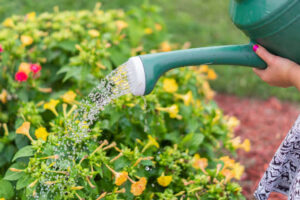When we talk of water-wise landscaping, it doesn’t mean you can lose the entire lawn or completely alter your landscape. To date, there exist several ways you can save water, and they are all at your disposal. In dry seasons, landscape watering can consume up to a third of the total water usage in your household. An inefficient sprinkler can deliver up to 300 gallons of water in an hour. This makes the process quite efficient.
This article discusses different water-wise landscape watering. Read on to find out.
Effective Water-Wise Landscape Watering Methods
Discussed below are some of the effective water-wise landscape watering methods.
Identify Permanent Features
This is an effective method that can give remarkable outcomes. Here is how you can implement it: On a piece of graph paper, estimate the average scale of your property. This includes the site of your house, large rocks, other buildings, slopes, surrounding vegetation, and any other crucial features.
Identify the Characteristics
The next thing you should do is tape a tracing paper over your plan’s base and sketch various characteristics and qualities of the property. This includes the existing shade, sun exposure, slopes, direction of summer breezes, and street noise. Furthermore, you can also identify the different soil types on your property, and if there are any drainage problems, you should fix them. If you fancy harvesting rainwater, you should locate spots where rainwater falls or align your roof to maximize its collection. Whether you are renovating an existing landscape or developing a new one, or just looking for methods you can conserve water in a home setup, proper design and planning is crucial for its success.
Identify Use Areas
This is another efficient step towards an effective landscape watering method. To implement it, you need to tape another piece of tracing to identify use sections correctly. It is highly recommended that you identify at least three areas: private, public, and service. To begin with, public spaces are apparent and tend to receive a lot of attention and water harvesting. On the contrary, private areas are primarily located in the backyard where families play. These areas are functional but receive less water than public spaces.
Plant Selection
After effectively planning out your landscape, it is time to start picking the best plants for each zone. To do, tape a new sheet of tracing paper over your plan’s base and introduce new plants. It would help to consider the use of areas, site characteristics, shade needs, and water-use zones. It is important to note that many native plants that do well in the coastal region are already water-wise. These plants have adapted to humid, hot weather and hot & dry weather. You are not limited when choosing plants with these characteristics. There exist hundreds of species of hearty and unique plants you can choose from. All you have to do is plant them in the right spot and allow them to get established. If you have challenges finding suitable plants, you can contact your cooperative extension, local water utility, or relevant agencies for more information.
Put Similar Plants Together
To reduce the cost of maintenance and watering, you can group plants with higher water needs and place them in a naturally moist spot. These spots could be at the bottom of a hill or in low-lying areas. The best sites to use low water-use plants are windy, dry spots, or exposed areas. They can also be used against the west walls of buildings or sunny south locations. Keeping plants with similar needs together will provide sufficient water for their growth comfortably. Whether you are irrigating by using an automatic timer or by hand, similar grouping plants will significantly simplify your watering sequence.

Soil Improvement
Did you know that if you carefully prepare plant beds, you can cut water usage by half? It is because soil plays a significant role in the water-wise landscape. Plants grow better in good soil because it absorbs and holds moisture better. This allows plants to grow deeper roots to access water even when the surface is dry. Improving soil quality makes your plants healthier and better adapted to low-water conditions later on.
What is Good Soil?
What are some of the characteristics of good soil? Here are some of them:
- It holds water well: Any good soil has this trait. Water retaining is key to growing healthy plants.
- Provides nutrients: No plant can survive in soils that don’t have nutrients. It is, there, crucial that soil provides these nutrients to plants.
- Is properly aerated: Proper aeration allows water to penetrate various inches to reach base areas. This is an essential trait of good soil.
- It has large particles: By having large particles, water flow and absorption are made possible. The importance of large particles is overwhelming because dense soil such as clay doesn’t readily absorb water. Instead, they are prone to runoff.
How to Improve Your Soil
If you are not content with your soil’s quality, here is how you can improve it.
Start by deep spading, rototilling, or plowing to break up the compacted soil. This allows the root systems to grow deeper into the earth. Adding organic matter like shredded leaves or compost is also vital while tilling. By doing so, you improve its distribution, penetration, and retention. It will also help if you add soil amendments as recommended by experts.
Another efficient way of improving soil quality is cutting back your grass. Nowadays, lawns that stretch from one property to another are no longer fashionable. They have more disadvantages than advantages. For example, they require a lot of fertilizer, herbicides, and fungicides.
This can be damaging, especially if you work under a tight budget. The quality of your soil depends on how well you maintain your space. Always put this in mind when working on your landscape.
